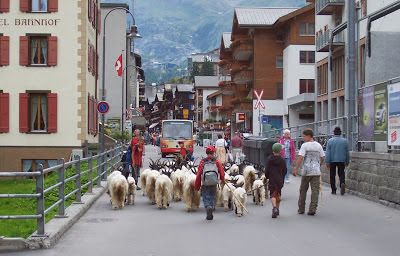The mountains of my life – Castor, my first Alpine peak
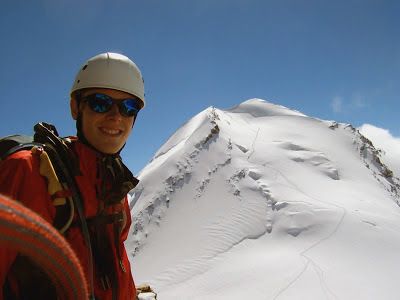 |
| ~ My brother James and Castor in the Swiss Alps ~ |
This blog post is part of a series of articles on mountains that have a special significance for me. See also: Bowfell, Tryfan and Stob Ban.
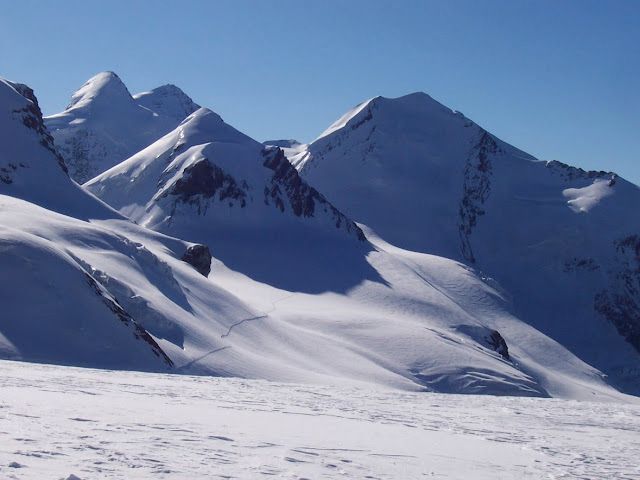 |
| Lyskamm, Pollux, and Castor (right) from the Breithorn Pass |
Castor is some distance from Zermatt. To get there, most modern climbers use the ski lift from the town to the summit of Klein Matterhorn, a peaklet next to the bulk of Breithorn. From there, an easy glacier crossing leads to Rossi Volante, a hut on the Swiss/Italian border.
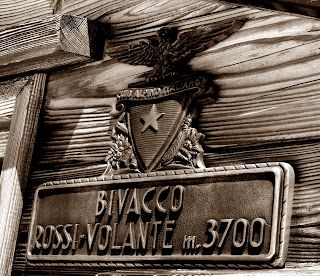 |
| Bivacco Rosse-Volante m. 3700 |
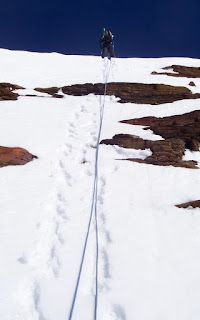 |
| The author abseiling down to the hut |
We soon discovered that Rossi Volante was not much of a hut–more a tiny little wooden box bolted to the side of a cliff. Getting to the hut proved to be an interesting exercise. Theoretically it would have been possible to climb down the slope beneath us, but the sun was fierce and the snow was in a terrible condition. We decided to abseil.
Apparently a chain is normally in place to act as an anchor, but it was hidden under the fresh snow. We excavated a ‘snow bollard’ and took turns to abseil down the slope of 50 degree slush and rubble. I hadn’t done too many abseils before and it was all very exciting!
The hut sleeps twelve in squalor, and is furnished with a variety of rotting mattresses and a picnic table (which takes up about a quarter of the room inside). There were holes in the floor and the snow around the hut had obviously been used as a toilet by previous occupants. Fortunately we were the only residents, and we spread our gear around to prepare for the night.
Sleeping is difficult at high altitude. Breathing is rapid, and it’s difficult to become relaxed enough to drift off. The sounds of the mountain and the creaking of the hut kept us awake. By the time 3am came round we were glad to get up and get on with the day.
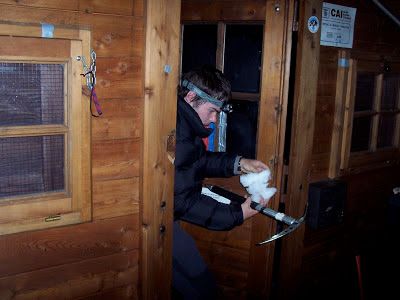 |
| Collecting ice for the 3am brew |
The temperature was a long way below freezing outside and we both wore our insulated down jackets for the descent to the glacier. Picking a route down to the bottom of the cliff proved to be a complex job in the dark, and after faffing around for a while we ended up descending a snow slope that had obviously avalanched at some point in the recent past. Instead of rapidly soloing down this slope we decided to do it the British way with roped pitches. It wasted some time, but at that point in our climbing careers we weren’t confident enough to solo steep snow in the dark (a skill required of every Alpinist!)
The sun came up soon enough, and we were treated to the spectacular vision of Alpenglow at dawn. Light burst above the distant Dauphine range and Mont Blanc shone like a new penny on the far horizon. It was a moment of wonder for us both.
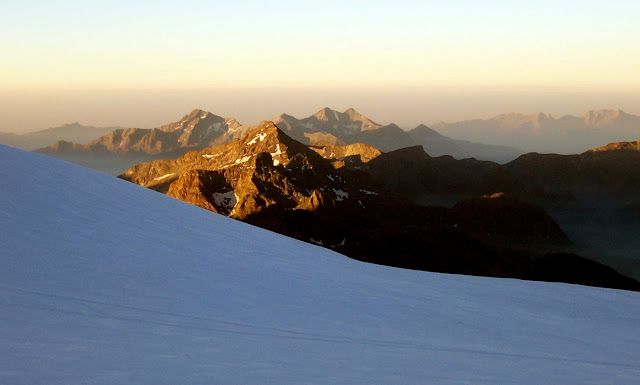 |
| Our first Alpine dawn |
The West Face of Castor reared up ahead of us: a huge wall of snow and ice, seamed by crevasses and topped by a crest painted gold by the first rays of dawn. To our inexperienced eyes it was an Everest, but from my present perspective, looking back on it after years of climbing in Scotland, it was a straightforward if longish Grade I snow plod.
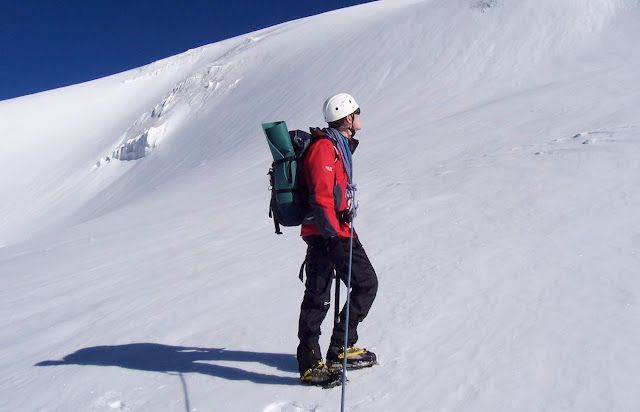 |
| “Es geht?” |
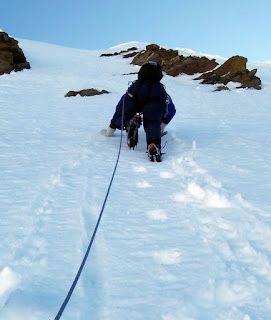 |
| Me climbing the last few metres to the ridge |
The ascent was relatively uneventful. A few other early birds were following the same trail: two ahead of us and a few behind. The piste zig-zagged to and fro across the slope and, I confess, was a little monotonous, but the unfolding view more than compensated. Breathing grew more difficult in the thin air and a few rests had to be taken. Near the summit ridge we encountered a crevasse which was spanned by a bold step, and then only a few metres of steepening snow lay between us and victory.
Breaking out onto the summit ridge of Castor was one of life’s most memorable events. I stood on a tightrope of snow the width of a railway sleeper. Behind me lay the vast gulf of the West Face, ahead the even more precipitous drop to the Gornergletscher miles beneath. A panorama of jagged peaks opened up all of a sudden on all sides, a realm of snow rising above the summer green in the valley further below than I would have thought possible. For the first time in my life I stood on a mountain top above 4,000m. It was a defining moment.
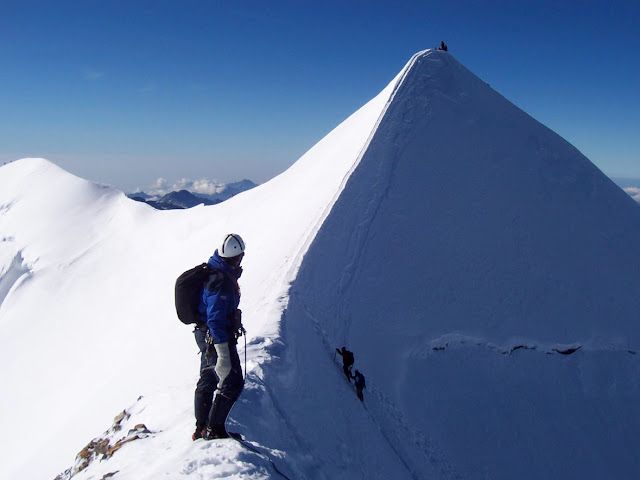 |
| The author on the summit ridge of Castor |
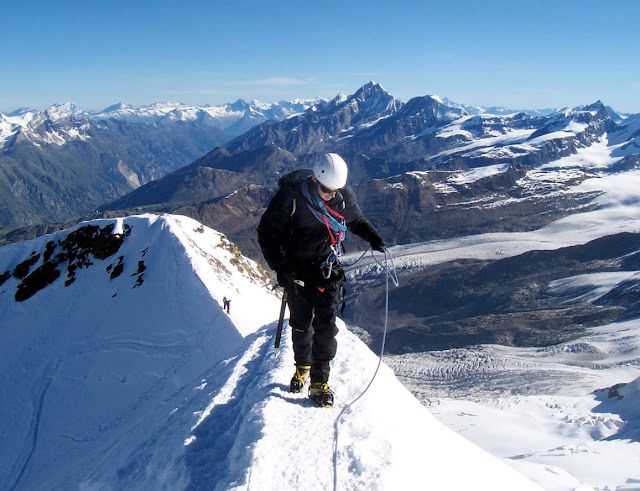 |
| James trying to coil the frozen rope |
The view from the summit could not have been more spectacular, and to this day I don’t think I have seen a finer one. The overwhelming sense was one of the sheer depth, of scale: the chasm below us was truly vast, and the mountains on either side, even higher than the pinnacle on which we stood, spoke of future challenges and a lifetime of adventure yet to be enjoyed.
We descended in good time, picked up our gear from the hut, and raced back to Klein Matterhorn in time for the cablecar down to the valley. To say we were pleased with ourselves would be an understatement; we had climbed our first 4,000m peak and lived to tell the tale! I think our expedition to climb Castor is a perfect example of all that is good about mountaineering. It wasn’t about technically difficult climbing, it was simply about the sheer enjoyment of getting to the top of an aesthetically stunning peak.
This wasn’t the last time we climbed Castor. The next year we returned and climbed it as part of a longer expedition to Lyskamm. On our way to this higher peak we had to climb Castor not only once, on the way there, but also on the way back to the hut! Now that was a big day out…
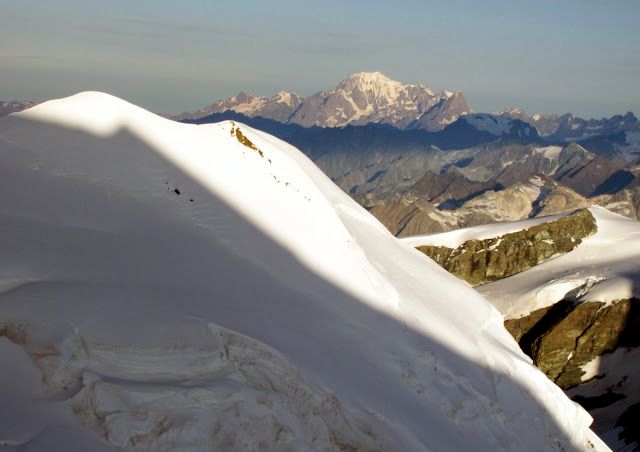 |
| Looking back to Castor and Mont Blanc |
Alex Roddie Newsletter
Join the newsletter to receive the latest updates in your inbox.

